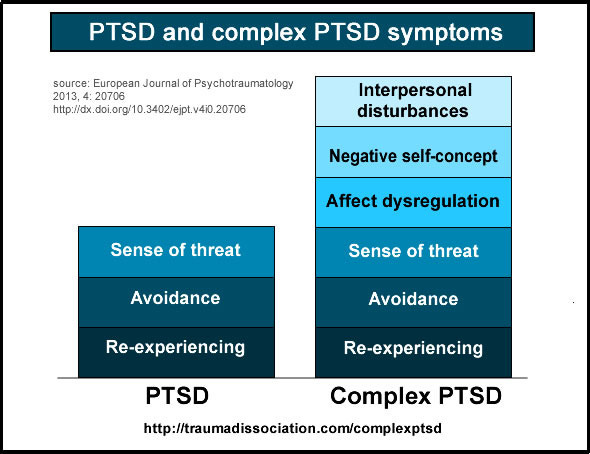How Complex-PTSD Fuels Depression and Anxiety in Youth
New research shows Complex PTSD often precedes and predicts depression and anxiety
[Note: Above is an AI-generated read-through of the text summary below]
Hi everyone,
We’re making today’s article free for all of our readers. If you’d like to also get the Thursday editions in the future, you can subscribe below. Thanks, and enjoy the summary. As always, let us know if you have any thoughts or feedback.
"As a result, complex PTSD can become a foundational issue, significantly increasing depression and anxiety over time" (Liu et al., 2025)
About 1 in 3 adolescents report being bullied.
And for many, the impact doesn’t end when the bullying stops. The emotional wounds can persist and even intensify over time. A study from the United Kingdom previously found that individuals who were frequently bullied were significantly more likely to experience anxiety and depression later in life.
Now, a new study takes this further, looking at how symptoms of complex PTSD (CPTSD), depression, and anxiety develop and interact over time in people who experienced childhood bullying.
First of all, what is complex PTSD?
It’s a condition that can develop from prolonged or repeated exposure to traumatic events and includes the core symptoms of PTSD, like flashbacks and hypervigilance, but also deeper disruptions: feeling emotionally numb or disconnected from others, struggling to calm down, and carrying a persistent sense of worthlessness or failure.
Some context: The Diagnostic and Statistical Manual does not include Complex PTSD as a separate disorder, while the World Health Organisation’s International Classification of Diseases does include it as a separate and distinct diagnosis

In this new study, the researchers looked not just at overall levels of anxiety, depression, and CPTSD, but also at how specific symptoms interacted with one another over time. This helped them understand which symptoms tend to show up first, and how they might trigger or worsen other symptoms as people grow older.
The Hidden Pathways of Psychological Fallout
The researchers tracked nearly 6,700 adolescents and emerging adults with histories of bullying across two age groups and found that CPTSD symptoms not only co-occur with depression and anxiety but often precede and predict them over time.
In adolescents, for instance, depressive thoughts of death ("I wish I were dead") appeared to fuel core CPTSD symptoms like worthlessness and failure. In emerging adults, it was the physical symptoms of depression, like slowed movement or restlessness, that were more predictive, linked to trauma-related dreams rather than flashbacks.
Across both groups, one CPTSD symptom stood out: “feeling like a failure” consistently acted as a central hub, often triggered by other signs of distress.
One Trauma, Many Diagnoses
The study challenges the idea of treating depression, anxiety, and CPTSD as completely separate. Instead, it shows how these conditions are closely connected, with symptoms that affect and reinforce each other in people who’ve experienced trauma.
This reinforces the need for clinicians to assess beyond primary complaints. A client who seems to have general anxiety might actually be dealing with unresolved trauma, where feeling on edge, avoiding things, and having a negative self-view are quietly shaping their emotions.
Targets for Intervention
Perhaps most actionable, the study identifies specific symptoms that could serve as high-leverage intervention points. For adolescents, this includes addressing suicidal ideation early, not only as a crisis in itself but as a possible driver of deeper CPTSD symptoms. In young adults, signs like being easily startled might be a key way to begin addressing deeper emotional struggles.
It’s a reminder that in trauma treatment, symptom priority matters. What’s most visible may not be most causal.
A Case for Precision in Trauma Care
The findings add urgency to the call for precision-focused mental health care. Rather than treating diagnoses in isolation, we need to trace and disrupt the symptom networks that sustain them, especially in youth with a history of relational trauma like bullying.
For mental health professionals, the implications are clear: early trauma care must look not only at what hurts, but how it hurts and when. Because what begins as schoolyard cruelty can grow into a lifetime of compounded psychological suffering.
But with the right tools and insights, it may not have to.
Takeaways for clinicians
1. Prioritize Trauma Screening in Bullying Survivors
CPTSD symptoms may drive depression and anxiety over time.
Clinical action: Assess for CPTSD in clients presenting with affective symptoms following bullying history. You can use tools like the International Trauma Questionnaire ITQ.
2. Start With Symptoms That Come First & Look for Symptom Feedback Loops
CPTSD, depression, and anxiety don’t exist in isolation. The study found they influence each other over time, but that CPTSD symptoms often came first.
In adolescents, suicidal thoughts like “I wish I were dead” often come before, and may fuel, core CPTSD symptoms such as feeling worthless or like a failure.
In young adults, physical signs of depression, like restlessness or slowed movement, were linked to trauma-related nightmares.
Clinical action: Because they can be gateways to broader groups of symptoms, focus early interventions on high-risk symptoms through treatment frameworks such as dialectical behavior therapy, cognitive behavioral therapy for suicide prevention, and behavioral activation.
3. Learn about CPTSD and provide psychoeducation
Here are some resources that can help you to better understand CPTSD:
And a deeper dive here
And another deep dive here into why the International Classification of Diseases 11th Revision added complex PTSD as a separate and distinct disorder
Attribution: This summary was created by the team at Psychvox and is based on insights from the article “Longitudinal Cross-Lagged Relationships of Complex Post-Traumatic Stress Disorder, Depression, and Anxiety Among Adolescents and Emerging Adults With Childhood Bullying Victimization Experiences” by Mingxiao Liu and colleagues. All rights to the original research remain with the authors and the publisher. This summary is intended for educational purposes only and does not imply endorsement by the original authors. The article is licensed under the Creative Commons Attribution 4.0 International License (CC BY 4.0).

